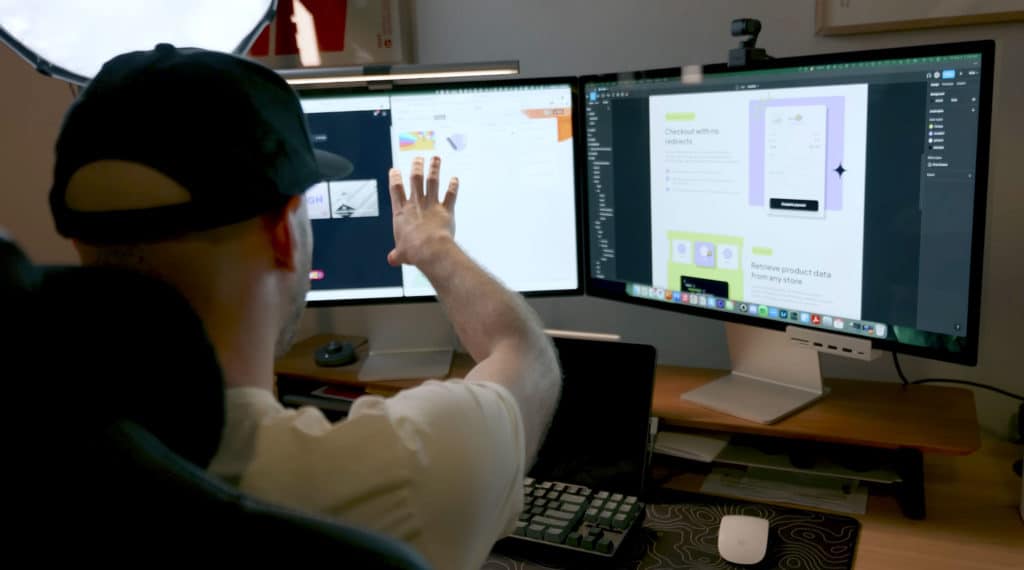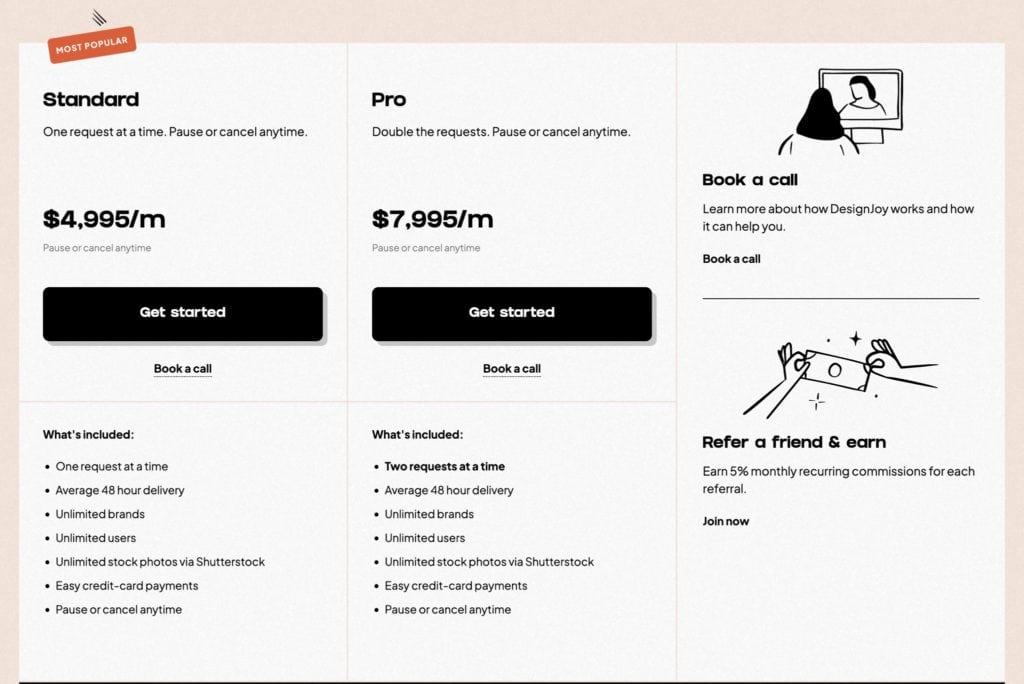
Excited to have you here, Brett. What’s this thing with Designjoy? What’s the genesis of this whole project?
So it’s basically what you commonly refer to as a productized design service, which means taking a design and selling it in an off-the-shelf sort of method. The way I do that is in the form of a subscription.
You’ll see a lot of these popping up now, especially if you’ve been on Twitter. But I started mine called Designjoy back in 2017 and have been running it ever since solo. I don’t have any employees or contractors. I do all of the design work myself and have been running it full-time for about three and a half years.
What made you decide on the subscription model? You could do freelance, hourly, retainers, fixed rate, or even value pricing.

It was kind of born out of a need to stand out. Everyone else is doing the traditional things like working for a company, freelancing, or starting an agency. I didn’t like the probability of my success in any of those fields.
So I wanted to do something different. I had come across the model previously and thought it could easily apply to my skill set and talents. I knew I probably had a better chance of succeeding this way than any other form of being a designer. It was really just out of necessity to stand out.
Who are Designjoy’s typical clients?
The software as a service base has been my bread and butter. They’re usually technology companies doing some product work. Sometimes they’re service-based companies as well, but they tend to be in the technology space.
The other half are other agencies, whether they have current developer or design support internally, or they’re looking to add that to their business through Designjoy. It’s about a 40/60 split, 40% being other agencies.
From what I understand, your most popular package is around $5,000 a month?
That’s right. $5,000 a month is the most popular package. There are quarterly and annual packages as well. You can get a discount if you lock yourself in, but 99% of people just go from month to month.
It works to my advantage, especially with businesses that have a budget and cash flow. They might not want to hire a full-time designer with all the associated costs, so my model offers a low-risk solution with lots of upside.
When you doubled your rate, you must have had some backlash. Did you get angry emails or upset clients?
Surprisingly, I did not increase the rate for existing clients. Some clients still pay less than $2,500 a month. The mission was to curb demand a bit. I wanted to take a breath and stick to the $5k rate.
At $2,500, I had an overwhelming demand because it was so cheap. Now, at $5k, I sleep well at night, knowing I deliver great value and I don’t have to constantly overproduce.
What’s a common myth about Designjoy and its business model?

The most common misconception is how manageable it is. People think I work 14-hour days, but that’s not the case anymore. I used to have double the clients, but now I prioritize a work-life balance. I’m a family guy. I have three kids and a wife, and I don’t want to work nonstop.
The idea is not to work yourself to death but to give you back your life. I teach people to just get a few clients, charge a good rate, and work only a few hours a day.
Is there something that you would change if you had to start Designjoy from scratch again?
I was really hard at saying no. I just couldn’t say no to clients who are just waving money in front of your face and you say yes. Then you realize it’s your fault and there’s no escaping it. There’s no vacation, there’s no time off. It’s sick to bed, never having a break all your life.
Knowing what I know now, I’m very good at being a little bit more choosy about who I let into the service. So I would just guard my client base a lot more than when I was very eager to make it to where I am today.
Especially when you’re starting a business, you have to be desperate to a certain extent. You have to do things you wouldn’t normally do. I charged way less. I worked way more to begin. Now I’m better at saying no and better at managing just the volume of work that I took on.
How would you recommend people approach offering a different type of service?

Honestly, don’t approach it any other different way. I mean, there’s a reason why my skill set only allows me to work with no code tools. So my tool of choice would be Webflow. But the same is necessarily applicable to Squarespace, Wix, or X, whatever is coming up and is getting really popular.
So the same kind of model applies because you are still, at the end of the day, working within some sort of constraints, right? I purposely keep my web development work within the constraints of what is natively possible within these platforms because in a lot of them, you can plug the world and bring in all sorts of scripts and stuff and then you’re opening yourself up to invariably more possibilities that may or may not be possible, maybe hanging you up.
So I always tell people, if you’re getting into doing a no-code prioritization service, keep the scope of work very limited in terms of what’s natively possible in the platform so that you can execute the work. At the end of the day, what you don’t want to do is get a month into a project. They come up with some really important feature that isn’t possible in the platform and you spend a lot of time trying to figure that out.
The way that I do it, I do so with Webflow. Obviously, design is my primary platform, but Webflow is an add-on to that service that you can subscribe to separately. It’s $1,000 extra a month, but you have to have the design package too. So it’s totaling $6,000 a month and it basically works the same way as I do design.
We’ll design the site in Figma, have all the design work there, export the assets, put them in the Webflow, and just work through page by page until the project’s done. A lot of times, this is the most hands-off portion of our engagement with the client because it’s just a matter of whether we have what we need to build now. We just got to make it happen.
So there aren’t really a lot of approvals or anything that I have to go through. So it’s actually way easier to do the Webflow side than the design because there’s not as much back and forth, but inevitably it does take longer, right?
Do you suffer from the perfectionist syndrome?
I do experience that when working with a client for the very first time because I don’t want to disappoint people. I do have that perfectionist attitude where I’m like, this needs to be top-notch. Like I need to come out of the gate and really, like, impress them.
So I’ll spend more time on that, that first project than any other project. Once that’s done and out of the way, I’m like, sure, now I can just go for it. I don’t have to worry at all. I’ve set up the structure and the aesthetic and now it’s just a matter of pushing around the screen. So I don’t have the luxury of time to get perfectionist just overall with my work because everything is pretty much take a request and go one direction, right?
Typically when you have a design request, you can go a million different directions in terms of aesthetics and layout and this or that font or whatever colors. I have the approach where I just pick one right off the bat and don’t look back. I just go straight through it and don’t veer off any point or reverse and start over. So a lot of that again, comes from experience that everyone can operate that way and work out.
How do you personally manage your workload to prevent burnout?
I’ve been fortunate and unfortunate to go through that. I ran design tours for 5 years and worked literally from sun up until late at night. My wife would come make dinner, sit beside me at my desk once when she put the kids to bed, and eat. I did that for many, many years.
Eventually, I did burn out. I can’t even tell you how long ago it was, but it was the very first time I experienced it in my life. I was just so passionate about it. I had this business that was growing, making tons of money, and doing things I never would have been able to do. It kept me going until it just seemed like a snap of the fingers and I was burnt out.
I had experienced it for the first time. I had so many people telling me that it was going to happen. I’m like, no, you don’t understand me. Like I’m built differently. All of you guys, it turns out I was. It just took me a little bit longer to get there.
So now I’m protecting what I’ve built in terms of the size that I let it grow to and that sort of thing. So now I’m in a very good position where I work less than full-time hours and can take off a day here and there and whenever I want to.
I work as much as I want to enjoy what I do. And it really I couldn’t be in a better spot. Sometimes I pinch myself because I can’t believe I’m doing all this and not having to spend every waking hour working.
What’s a personal hobby or interest that you do to disconnect?

I love video games. That’s one thing. We built a home in my home state, Missouri, like I’m in Phoenix, where everything’s just cluttered and clinked together. So we had some land out there. I love going out there, being outdoors, all the little things that you take for granted when you live in a city. I love being able to do that. We do that a few months out of the year.
And other than that, we spend a lot of time in the house doing this or that or playing out in the backyard or something. So I don’t really have any crazy hobbies that I partake in, unfortunately, and I think that’s as a father of 3 kids and a family man myself, I can appreciate that.
Coffee or tea while designing?
I’m a sweet tea drinker. I’m from the Midwest. So, it’s really, really, really sweet tea. Not your traditional, like, hot tea. Yeah, I’ll drink that all day long, But not a coffee drinker, fortunately.
Let’s say you get a full 30 days off, like hitting a pause. Where do you go and who do you take with you?
Obviously, my family. With having kids, getting out of the country is probably off the table for us, at least. I know some people do it anyway, but for my wife, it’s a no-go. So probably just transport someplace tropical at Tahiti or something.
I’ve never been someplace tropical other than California. So yeah, I’ve always dreamed of going to an island or something and being on the beach and being in good weather. A cliche answer, I know, but that’s where I want to be.
Would you rather use Comic Sans as your only font for a year or work for an agency?
I would have to say work for an agency. To be honest with you, I don’t dislike the idea of working for an agency funny enough, and they hate comics. So yeah, probably that, if I just had to do it for a year. If you were to say like 2 or 3 years, I’d just be like, Comic Sans.

